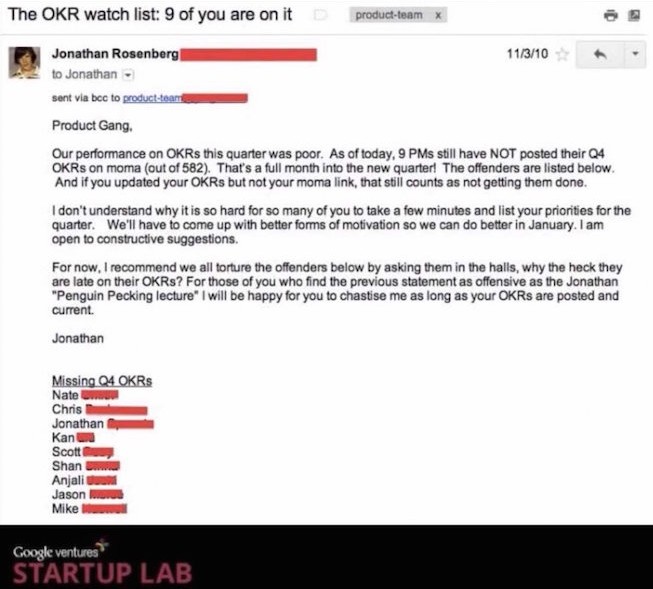Everybody sets goals. But success hinges on the ability to execute them. The OKR planning method is all about distilling your goals, focusing on the most important ones, and then following through.
OKRs were first developed in the 1970s at Intel by then-president Andy Grove, who wanted to answer two questions: Where do we want to go, and how will we know we’re actually getting there? His colleague John Doerr learned the method and later spread it to Google and other top Silicon Valley companies.
If you’ve learned the details of OKRs but aren’t sure how best to implement them at your own company, check out these 12 tips from top execs on adopting OKRs successfully.
John Doerr, VC at Kleiner Perkins & former Intel salesperson
Tip 1. Be patient. You probably won’t perfectly nail the OKR process the first time you try it. There’s usually a trial-and-error period, so don’t be surprised (or discouraged) if it takes your company a couple of quarters to really figure it out, or if the process doesn’t pan out exactly the way you expected.
Tip 2: Find an OKR champion. Identify someone (ideally someone in leadership) who’s 100% supportive of OKRs and fully understands them, and enlist them to help educate the rest of the team. They can assist with tracking and grading progress and help fine-tune the process.
Tip 3: Go all in. OKRs need to become part of your company culture and DNA. New employees should be trained in the process, all OKRs should be public, and grade and progress reporting should be prioritized. That’s how the process becomes successful and sustainable.
Tip 4: No dictators. There must be consensus on collective team and company OKRs, so that they’re supported across the entire organization.
Tip 5: Ideas should flow up as well as down. Although every team member should link their goals to corporate objectives, corporate goals should also be inclusive of ideas created at the individual level. This keeps senior leadership in tune with the organization, and it gives individuals ownership over what they’ll be working on day in and day out.
Rick Klau, Partner at Google Ventures
Tip 6: Get everyone on board. Everyone. A half-hearted effort will fall flat and is a waste of time, so make OKRs a commitment company-wide. Leadership in particular needs to make it clear that OKRs matter. Check out this email from a Google product manager calling out his team members who hadn’t yet posted OKR grades:

Tip 7: Find tools that support visibility. Decide what you’ll use to capture OKRs and how they’ll be shared — whether it’s Google docs, internal Wikis, or another collaboration tool. If you’re a Wrike user, take a look at this how-to guide for using OKRs in Wrike.
Tip 8: Keep the process lightweight. Don’t weigh it down with heavy documentation or a tedious series of unnecessary meetings. You should be doing the work, not talking about doing the work.
Tip 9: Always check the big picture. Draft your personal/team OKRs, then check them against company OKRs to make sure it’s all contributing to high-level objectives.
Jeff Weiner, LinkedIn CEO
Tip 10: Use OKRs to make your mission actionable. Too often a company’s mission is vague, or just a banner taped to the wall. Use OKRs to make your mission real, feeding your company’s culture and sense of purpose. Link your objectives directly to your company mission, where the means are clearly defined as key results. It will keep the entire company unified and moving in the right direction.
Tip 11: Show individuals that they matter. Effective leaders show how each person in the company can make a real difference when it comes to achieving high-level goals — every day and every quarter. So when you meet to define individual OKRs, make sure they support important company objectives in a tangible way to keep every employee engaged and motivated.
Dick Costolo, Twitter CEO
Tip 12: Prioritize communication. Remember that OKRs aren’t just a way to measure progress: more importantly, they’re a communication vehicle that shows other teams what you’re working on and what you’re trying to accomplish. Make sure teams are looking at each other’s OKRs and talking about them in order to encourage collaboration.
Want to learn more about OKRs?
If you’re curious about using OKRs in your company, take a look at this Slideshare for an outline of the entire process:
Related Reads:
If You’re Not Using OKRs for Quarterly Planning, Stop and Read This
How to Use OKRs in Wrike: A 6-Step Guide + Templates
5 Tips for Better Annual Planning
Sources: http://blog.betterworks.com/keys-okr-success-qa-john-doerr/; http://pando.com/2013/12/06/what-twitter-ceo-dick-costolo-learned-at-google/; http://firstround.com/article/the-management-framework-that-propelled-LinkedIn-to-a-20-billion-company; https://www.youtube.com/watch?v=mJB83EZtAjc




